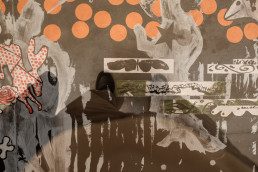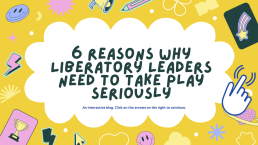MEASURING LOVE in the JOURNEY for JUSTICE
Below is the preface to this week's featured resource: Measuring Love in the Journey for Justice. Find the link to download this Brown paper at the end of this post.
MEASURING LOVE
Preface: A Sovereign Perspective
As this is a Brown—not white—Paper, we want to give some perspectives before you dig in. In a sovereign, self-determining perspective, we see Two Spirit people as sacred gifts. Children are treasured. Elders are respected and privileged. Womyn are beloved and respected and have power and voice. Fathers, sons, and boys are lifted up as the warriors, believers, and loyal friends that they are. Mothers, daughters, and girls are as valued as life itself, seen and treated as blessings. And all relations are sacred.
To be sovereign and free, our people need policies made of love, forgiveness, and connections.
As oppressed, exploited people of color in this work of social and racial justice, we have seen — and are seeing—children separated from their caregivers, caged in concentration camps. We are living in another era of the systemic denial of democratic civil rights. To be sovereign and free, our people need policies made of love, forgiveness, and connections. Our communities deserve health and educational equity; land and housing justice; economic independence; living wages (as in universal minimum income). Our people want restorative justice practices to replace punishment and lockup. Our communities want community organizing and advocacy, block by block. Our people need community controlled governance and accountability systems. We want civic leadership everywhere, as the right to vote goes with the rights to drive, assemble, drink, and travel.
This Brown Paper flips the script of what is acceptable as a “Paper” on its head. It is not a “formal,” research-based, finished product of the traditional type. It comes from the heart and is meant to be used—like love. It is meant to spark dialogue and provoke.
In it, we are asking ourselves, “Are we loving bravely enough?”
And “How much am I loving?” “What else I can do to be in community from a place of love?” and “How am I wielding power fused with love?”
These are the essential questions posed in our brown paper. We are excited to bring this out into the world to provoke, connect, and build with you.
We have so much to love. We love YOU because we know if you’re reading this paper, you know what it’s like to be powerless and not feel loved—and are working on bringing about more justice in the world.
We release our intentions into the universe. We want to know what your reactions are. We thank you for honoring us by your comments and discussion.
Spread your love. And, we know we are rising as one.

Download Measuring Love in the Journey for Justice HERE

Shiree Teng has worked in the social sector for 40+ years as a social and racial justice champion – as a front line organizer, network facilitator, capacity builder, grantmaker, and evaluator and learning partner. Shiree brings to her work a lifelong commitment to social change and a belief in the potential of groups of people coming together to create powerful solutions to entrenched social issues.
*After the Measuring Love Brown paper was released, Shiree's co-author was arrested on allegations of child molestation. She addresses this in a "Letter to Beloveds" - an excerpt from her next collaborative paper, Healing Love into Balance. (which will be highlighted at NW in the coming weeks.

Network Weaver is dedicated to offering free content to all – in support of equity, justice and transformation for all.
We appreciate your support!
donate in the box above or click here
Governance for System Change
The Complexity Spectrum blog describes how clock and cloud (non-system change and system change) approaches require fundamentally different strategies and tactics. The same goes for the mental models and processes we use to govern system change work.
In fact, governance for system change may not look much like traditional governance at all. Webster’s defines governance as “overseeing the control or direction of something.” Because system change work is emergent, long term and comprised of dispersed and diverse actors, centralized control and oversight is unworkable if not impossible.
Rather, system change work requires distributed decision making in pursuit of a common aspiration and in response to emergent facts on the ground. While centralized control may be impossible, there are ways to bring coherence to this work, increasing the probability of shifting a system to a more desired state.
In this case, governance applies to anyone who makes important decisions that affect the probability of success of a collective system change endeavor, and not just to members of a board of directors.[1] This type of governance is difficult and often requires building a range of new practices over time. Here are a few practices that may help:
- Capitalize on uncertainty to lower risk and increase chances for success.
- Focus on creating the conditions for change over short-term outcomes.
- Liberate choice rather than trying to control it.
- Rely on multiple ways of knowing as you navigate the journey.
Practice #1: Capitalize on Uncertainty
“Uncertainty is an uncomfortable position. But certainty is an absurd one.” -Voltaire
Depending on where you engage on the Complexity Spectrum, uncertainty can be a problem or it can provide a valuable opportunity.

Targeted solutions require a technical approach where you move efficiently along a mostly known pathway from a known problem to a known solution. Take for example a population that has been displaced by a natural disaster. We have experience dealing with this type of situation (known problem) and delivering the targeted solution of emergency shelter (known solution) though various tried and true means (mostly known pathway). In this case, uncertainty can be disruptive because it creates barriers between the problem and the solution.
Solutions at scale usually require an adaptive approach (think Human-Centered Design).
For example, in California many more people were eligible for benefits to alleviate poverty and food insecurity than were applying for them. The reasons why the problem existed were fairly well understood (sufficiently defined problem). In response, Code for America talked to people to understand why they weren’t applying and how they could provide a solution. They built an app, iterated it, and eventually launched a product (GetCalFresh) that greatly increased the number of eligible people applying for benefits (iterated to find a solution that was initially unknown).
An adaptive approach requires a fair level of certainty about the definition of the problem and its causes — enough to support a process of managed uncertainty in which you experiment to find deeper causes and solutions to the problem.
System transformation calls for an emergent approach.[2] In an emergent approach, while you are likely certain about the negative symptoms of the challenge (e.g., high levels of poverty or inequality), the deeper drivers of the problem and reasons for its persistence are mostly unknown or misunderstood. Consequently, the ways to address these drivers are also mostly unknown (or unformed). The key is to nurture the conditions that will support the system healing itself (e.g., understanding the systemic drivers of the challenge and supporting the emergence of ways to address them).
In an emergent approach, uncertainty unlocks opportunity. When complex challenges persist over time despite efforts to address them, there is often a sense of frustration, even despair. However, this can lead to the realization that we don’t have all the answers, which can make us more open to thinking differently.
Some forms of systemic analysis, like dynamic system mapping or participatory futures, provide a structured process for thinking in new ways about an all-too-familiar problem. When doing participatory system mapping, aha moments often arise when participants identify a pattern that explains why change has been elusive. It is empowering to see an old problem from a different perspective and find a possible path forward.
Effective system sensing should lead to confidence that you have “good uncertainty” — or trust that there are good questions to explore and a way to experiment and learn more about the system and how to engage it. Think of uncertainty as a gateway to doing things differently and finding ways to unstick a stuck system.
Practice #2: Focus on Creating the Conditions for Change
Uncertainty is uncomfortable because it increases our fear of failure. It makes us anxious. One common but ultimately unhelpful response is to over-rely on short-term substantive outcomes that are a small piece of the ultimate outcome we want to see. [3] For example, if we are looking to end human slavery in global supply chains, we might measure progress by looking for annual percentage reductions in the estimates of slave labor by 5% or so each year.
It is wise to understand the impacts our work is having in the short term, if for no other reason than to detect and mitigate potential negative impacts. However, there is a danger of using pre-defined, substantive outcomes as waypoints to navigate our way on the journey toward long-term system change.
Specifically, there are two key dangers:
- Short-term outcomes dominate our time, attention, and resources and reduce commitment to long-term change. According to neuroscientist Ian Robertson, “success and failure shapes us more powerfully than genetics and drugs.” This means short-term successes can lead people to invest more time, resources, and emotional commitment in concrete short-term outcomes instead of longer-term, hazier systemic shifts. Moreover, grantees often need to trade annual impacts for continued funding, so pre-identified short-term outcomes take priority.
- Short-term impacts can be bad predictors of long-term, systemic impact. In complex systems, impact is not static. What may seem like a good outcome in the near term, might drive negative downstream impacts in the months and years ahead. Basing future investments mostly on short-term outcomes can lead to bad long-term investments.
The implication is an inexorable pull away from making the hard choices and risk tolerance needed for system change. As a result, the pursuit of specific substantive outcomes in the short term may make it more likely a system change effort fails in the long term.
Fortunately there is an alternative. Alice Evans, who in her time at Lankelly Chase helped build their systems practice, said a key enabler of their work was the realization that creating the conditions for system change should be their focus rather than targeting specific outcomes those conditions might produce.
For example, there are a few generic conditions that will apply, in some form, to most system change initiatives. These include the degree to which important system actors can:
- See their context as a complex system and use that shared understanding to inform action and increase the potential coherence of distributed action.
- Identify and engage patterns that people believe will unlock change (e.g., weakening patterns that sustain the problem or strengthen bright spots that can shift the system).
- Build or strengthen connections, networks, and information flows across the system.
- Build an infrastructure for learning and, as Marilyn Darling says, “return that learning to the system.”
Elaborating these and other conditions that might support system change requires a participatory process that prioritizes the voices of those closest to the day-to-day operations of the system.
As we look at the conditions we are trying to cultivate, we must also look at those in ourselves and in our organizations. We are all part of the respective systems we are engaging and it’s critical to contend with power and who is making decisions both within an organization and in a broader system impacted by those decisions. If you haven’t already done work on your own relationship to power and how it impacts your work, now might be a great time to dig in. Consider asking:
- How are we showing up in the system? What feedback are we getting about how we’re showing up? Are we working in a system-informed way? How do others experience our presence?
- What is the quality of our relationships with other key system actors? How have we prioritized the voices of those closest to the context?
- How do we understand our own power in the context we are working in and the people we are working with? How do others perceive it? How can we engage others in an honest conversation about our relative power?
Fortunately, changing how we show up in a system shifting initiative is a condition over which we have the greatest control. Unfortunately, many of us, especially funders, show up in ways that replicate or entrench unhelpful power dynamics that constrain choice and make distributed decision making impossible. This means a critical early condition for system change is understanding and adapting the ways in which our organizations — and even ourselves — work. For more thoughts on internal organizational conditions and how to work toward them, see Building Emergent Organizations.
Practice #3: Liberate Choice
Successful system change requires those closest to the day-to-day operations of the system to be highly adaptive over time in response to emerging realities.[4] However, this is hard to do with traditional governance processes that seek to maximize control and minimize risk.
For example, a standard grant agreement trades funds for outcomes identified by the donor, which replicates the power dynamic of “those with resources call the tune.” This dynamic too often prioritizes donor interests rather than those most impacted by the funding, removes agency from those closest to the context, and creates highly transactional relationships.
If funders behave in ways that reduce the agency of these actors, they inhibit their ability to work for system change.
The alternative to donors limiting choice is to use what Cyndi Suarez calls “liberatory power,” or the ability to “create what we want” by transforming “what one currently perceives as a limitation.”[5] A key question for donors wishing to support system change is, how can we increase the ability of key actors in the system to effectively connect with each other, sense, sense-make, act on, and learn from their system?
Each level of actor in a system change initiative can liberate the choices of actors in the system. Liberating choice is not the same as giving more choices — it requires both the presence of choice and the agency to act on it. A board of directors needs to liberate choice for organizations they oversee; leadership of an organization needs to liberate choice of its program teams; program teams need to liberate choice of grantees and partners; grantees and partners need to liberate choice of stakeholders and community actors; and based on how information flows in the system, stakeholders can liberate choice for program teams, etc.
This is not the same as simply giving money and getting out of the way. Liberating choice does not mean removing all structure. Many argue there is no such thing as structurelessness when it comes to any kind of group activity, especially when one actor is providing significant resources to support the work of other actors.[6] Donors need to provide enough structure to enable choice, but not so much as to prematurely curtail choice.
The key is to create minimally sufficient, helpful structure. For donors supporting system change, there are some key components to creating minimal structure, which include:
- Articulate a common aspiration or guiding star.[7]
- Clarify boundaries by articulating key interests and values.
- Establish an infrastructure for learning.
- Invest time in building trusting relationships among system actors.
Of these four points, clarifying boundaries or guardrails may be the most difficult. An unhelpful but familiar way of doing so is to provide directives to either do or not do something. A more useful approach is the “even-over statement” as developed by Tom Thomison and popularized by Aaron Dignan.
The benefit of even-over statements is that they share how different actors in the system might make tradeoffs between key interests and values. The statement consists of two “good things” and says, “if confronted with a choice, I would choose this good thing over that good thing.” However, it aims to preserve the agency of an actor to make a decision in light of the specific situations that they find themselves in.
Some generic even-over statements that liberate choice for system change include:
- Prioritize responsible, smaller experiments even over concentrating resources on large-scale bets.
- Invest time in building trusting relationships even over delivering on preset timelines.
- Value responsible learning even over clear-cut wins.
- Foster regular, honest feedback across the network of actors even over preserving harmonious relations.
Whatever boundaries you try to set, and however you set them, they will be wrong in some respect. This is where a dynamic learning process is essential. Part of that learning process needs to ask to what degree are the boundaries and common aspiration helpful? In what ways are they affecting people’s thinking and behavior? Are they strengthening agency of system actors or reducing it? What might we do better?
And none of this works if the relationships between actors in a system change initiative are mainly transactional. Because system change work is highly emergent, it requires real time and honest communication and the ability to work in a decentralized way. All of this requires high levels of trust between actors, and this level of trust does not happen unless they invest time in it. This can be particularly difficult for funders who see investing time to build trust as simply increasing overhead.
Practice #4: Rely on Multiple Ways of Knowing
“There is a strong bias in the U.S. dominant culture, one that shows up in the nonprofit sector as well, to value only one way of knowing, the one grounded in data, analysis, logic, and theory — a rationalist’s approach to truth.” -Elissa Sloane Perry and Aja Couchois [8]
Working effectively in complex systems requires strengthening our ability to use multiple ways of knowing. It is essential for implementing the practices described above. Unfortunately, as the quote from Elissa Sloane Perry and Aja Couchois indicates, the default capacity for many in the West is to privilege only one way of knowing — a cognitive, analytic approach.
This is not to say we should devalue rational analysis. Rather, it means putting a high value on the ways others understand their world and make decisions about how to act.
There are various ways to define multiple ways of knowing, from Howard Gardner’s theory of multiple intelligences to the model of five minds described by Tyson Yunkaporta.[9] A simple way to look at multiple ways of knowing is: thinking, feeling, and intuiting.[10] At a minimum, it means asking: what do you think about the situation, how does it make you feel, and what is your gut telling you to do? It means listening to how others think, feel, and intuit.
Listening to feelings and intuitions is not the same as following them. Rather, it means understanding how information, situations, and decisions make us and others feel; allowing our intuitions to come to the surface; and not automatically subjugating these to what we might judge as rational or rigorous analysis. It means sitting with differences and uncertainty and valuing the important stories people tell about their system, and not just the numbers they can fit on a spreadsheet.
For many, this is the most disruptive practice for system change governance. It requires us to change how we think about and develop strategy, how we evaluate our effectiveness and that of our grantees, and how we make decisions. It means that good questions are often more useful than seemingly good answers. Fundamentally, it changes how we know what we know (e.g., how we weigh a quantitative analysis versus the lived experiences of partners on the ground).
But as disruptive as it can be, cultivating multiple ways of knowing is worth it. There are several reasons why: from the neuroscience that shows the role of emotions in decision making to the necessity of multiple ways of knowing for advancing equity.
In addition, there are simple, practical arguments for cultivating multiple ways of knowing from a system change perspective:
- If shifting systems involves diverse actors spread across geographies and cultures, different ways of knowing will always exist in the network. This means effective system change work requires the ability to understand and work with those different ways of knowing.
- And, because complex systems are murky and constantly changing, it is naïve to rely on only one way of knowing. Each way of knowing has limits but, together, multiple ways of knowing increase our effectiveness.
- Lastly, multiple ways of knowing are essential because we can’t just reason our way to system change — rather it requires a dynamic connection between head, heart, and gut.
One accessible way to start bringing multiple ways of knowing into your work is to play with meeting structure. Try starting meetings with a check-in question like “how are thinking and feeling coming into the meeting?” Or you could ask something more playful like “what was your favorite movie character as a kid?” A more serious question could be “can you describe a time when you felt truly happy?” Think of it less as an icebreaker and more of a space for people to welcome in their whole selves and deepen relationships. It also helps to build in time for silent reflection in the room, have people journal, or to pair up and process the meeting while taking a walk.
Many people have built more in-depth ways to incorporate multiple ways of knowing. A few I suggest are: the Equitable Evaluation Initiative, for using multiple ways of knowing to build more equitable evaluation processes; Relational Systems Thinking: That’s How Change Is Going to Come, from Our Earth Mother by Melanie Goodchild, for how to realize the benefit of differing world views and ways of knowing; and Theory U by Otto Scharmer, for a comprehensive approach to system change that has multiple ways of knowing at its core.
Next Steps
Learning to use a different frame for how we govern system change is a practice, and it takes time to develop. Devoting time to consciously changing your governance practices is the first challenge you will confront. But remember, systems seldom change on a dime, and neither do we. You might want to start with the system you know best and are closest to — you and your own organization.
One way to start is to use these governance practices as a set of prompts for your own self-reflection and experimentation, such as:
Using the Complexity Spectrum. How are we differentiating among our organization’s approaches along the Complexity Spectrum? Are we developing different mindsets and practices for clock versus cloud initiatives (e.g., solutions at scale versus system innovation or transformation)?
Capitalize on uncertainty. How are we cultivating good uncertainty and capitalizing on it? Are we resisting the urge to create certainty when there is none?
Liberate choice rather than trying to control it. Do those closer to the context feel they are able to make the choices needed to engage the system effectively? How well are our aspirations, guardrails, and learning processes helping us learn from the choices we make? What levels of trust are we able to build?
Focus on creating the conditions for change. What are the conditions that will support change in our organizational system? How well are we supporting them? How might we revise them? How are we understanding what others in the system feel are the conditions that will drive change?
Rely on multiple ways of knowing as you navigate the journey. Are we getting in touch with our own ways of knowing and cultivating openness to others? Are we trying both small and large experiments? (e.g., creating space in meetings for check-ins and reflection time? Building a more equitable evaluation practice or sitting in the tensions between different world views?)
Lastly, give yourself and those around you room and permission to change. Rather than expecting to get it right, focus on getting it better. Together I think we can do just that.
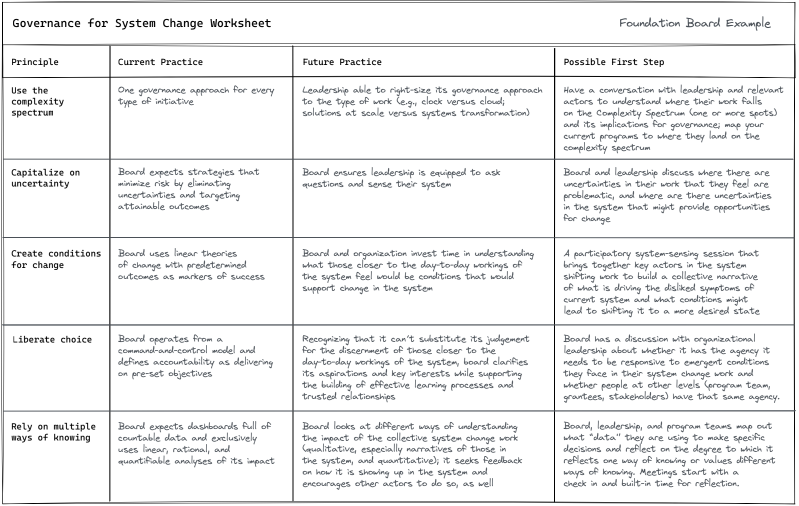
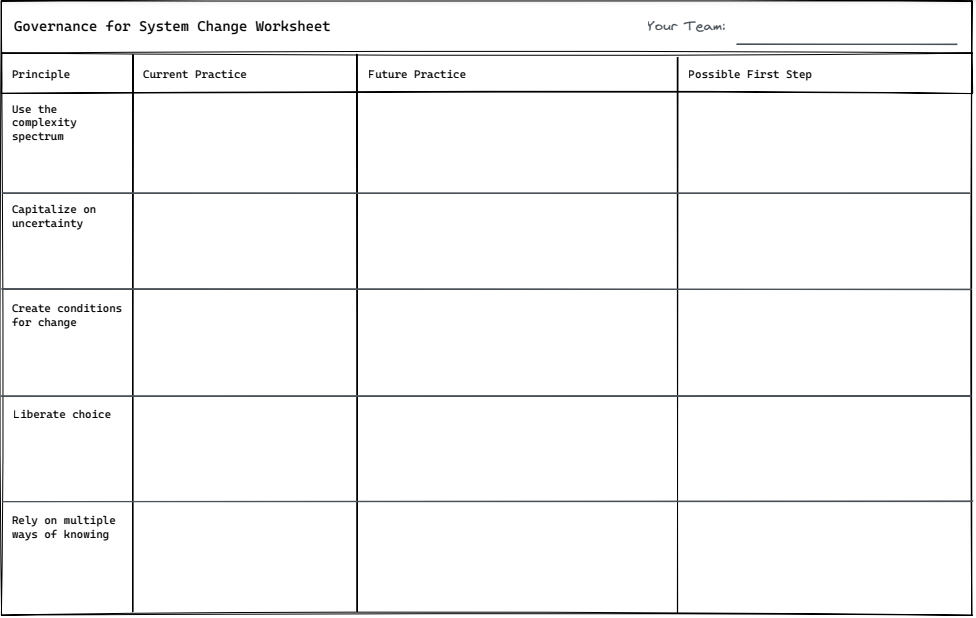
Download a PDF of the blank worksheet
Download a PDF of the example worksheet
Acknowledgement: While I take responsibility for the words used in this blog, the ideas come from dozens of colleagues, hundreds of conversations, and thousands of hours of experimenting and learning by many.
[1] I will often refer to the work of a foundation board because this is the context I know well.
[2] I am using the terms technical, adaptive, or emergent approach instead of technical, adaptive, or emergent strategy to avoid confusion with established writing on these types of strategy. There is a fair amount of commonality of usage of the terms technical, adaptive, and emergent between this piece and earlier works, but there is not 100% overlap and I want to avoid confusion or to imply that I am redefining these types of strategy. For writing on the subject, see the works of Ron Heifetz, Adrienne Marie Brown, and Henry Mintzberg.
[3] In this case, substantive outcomes mean measurable changes to the symptoms of the problem we are concerned with, as opposed to the process by which we work.
[4] This is particularly important when working with complex systems where those closest to the context need the ability to respond to what they are learning. This is what Gen. Stanley McChrystal found in doing counterinsurgency work and wrote about in his book, Team of Teams. McChrystal saw the need to empower choice from units on the ground by creating more distributed decision making.
[5] See The Power Manual by Cyndi Suarez, p. 13.
[6] See The Tyranny of Structurelessness by Jo Freeman who wrote about organizing the women’s liberation movement in the 1970s. Here is a relevant passage: “Contrary to what we would like to believe, there is no such thing as a structureless group. Any group of people of whatever nature that comes together for any length of time for any purpose will inevitably structure itself in some fashion. The structure may be flexible; it may vary over time; it may evenly or unevenly distribute tasks, power, and resources over the members of the group. But it will be formed regardless of the abilities, personalities, or intentions of the people involved.”
[7] For guidance on developing a guiding star, see the Systems Practice Workbook.
[8] Multiple Ways of Knowing: Expanding How We Know, April 27, 2017, Non-Profit Quarterly.
[9] Here is a quick description of the five minds.
[10] Here a quick explanation of the science of intuition: “Intuition is a form of knowledge that appears in consciousness without obvious deliberation. It is not magical but rather a faculty in which hunches are generated by the unconscious mind rapidly sifting through past experience and cumulative knowledge.”

Rob Ricigliano is the Systems & Complexity coach at The Omidyar Group, where he supports teams as they engage complex systems to make societal change.
originally publshed at In Too Deep
featured image by kazuend on Unsplash

Network Weaver is dedicated to offering free content to all – in support of equity, justice and transformation for all.
We appreciate your support!
Ceremony: Reyoking the Sacred with Our Social Justice Work
“Disability is an invitation to relationship…It’s that opening that creates the whole ecosystem.”
– Sophie Strand
“Poetry is the language of the apocalypse.”
– Bayo Akomolafe1
As the newest members of turtle island, two-leggeds have always relied on ceremony for connection with, and for instruction from, older forms of sentience and the divine. Ceremonies are an essential part of all cultures across time. It is the absence of such sacred practices that results in disharmony, imbalance, and collective dis-ease. But what ceremonies and by and for whom? As social justice practitioners who come from a broad range of communities, cultures, and traditions, we often have few, if any, shared approaches for bringing together people, place, and spirit. This challenge has only been compounded during the pandemic, which has shifted so much of our work to a video screen.
While there are a number of rituals—often used by social justice practitioners—to help people connect across the virtual landscape, these tend to have more intellectual and emotional dimensions than spiritual. The increasing attention to somatic practices is expanding how we engage with one another in healthy and embodied ways, but our connection to the sacred, to sentience in its myriad of forms, to place—whether it be turtle island as a whole or a particular place on the carapace of her shell—is largely absent in our cross-cultural social change work. And it is this absence of ceremony that is impeding our ability to radically transform, as people and as a complex and interdependent ecosystem as a whole.
Members of the Change Elemental team and many others have written about the importance of inner work, of attending to the interiority of the intervener. But this work is often done separately, as individuals, or in our own spiritual communities, and not centered as much in our collective change efforts. There are exceptions of course, but these only make more stark the general absence of collective practices.
What is needed, what has always been needed, for transformational change, is ceremony—ceremonies in which we reconnect deeply with each other, with great spirit, with all of creation. In God is Red, Vine Deloria, Jr. describes the importance of ceremony for Native peoples. “The task of the tribal religion, if such a religion could be said to have a task, is to determine the proper relationship that the people of the tribe must have with other living things…” As all of creation is sentient—lizards, rocks, trees—then proper relationship is necessary with everything. And how that relationship is learned, celebrated, and restored, is through ceremony.
The healing of injustices and the restoration of aki, of the earth—including all of the creatures who depend on her and on whom she depends—requires restoring indigeneity—that is a deep connection to place, to its sacredness and interdependencies, to cultural sensibilities that are shaped by these.2 This is an individual, collective, and planetary necessity. The restoration of indigeneity requires reconnecting to indigenous practices, whether those practices are indigenous to the Americas, Africa, Asia, or Europe. For those who are not connected or actively reconnecting, this then is your task—and yes, it can be complicated, painful, and messy. It is an extension of inner work, of cultivating the ability to be present to what is and was and then draw on this ability to help create what will be.
And too, when we come together as change makers, we must hybridize and invent new ceremonies to support our current collection of igneous, sedimentary, and metamorphic beings—all while centering the primacy of the indigenous world in which we are currently walking. It is a potent task, but not without antecedents.
The evolution, resistance, and resilience of indigenous spirituality in the face of settler colonialism and the middle passage provide some clues for how we might accomplish such transgressive divination. And while these adaptations were the result of subjugation and duress, our current times—the extraordinary amount of injustices we are quite literally buried in—necessitate another sacred leap in order for us to work collectively together.
So, how do a diverse group of social justice practitioners develop and practice ceremonies together? One answer can be found in Braiding Sweetgrass by Robin Wall Kimmerer:
I knew that in the long-ago times our people raised their thanks in morning songs, in prayer, and the offering of sacred tobacco. But at that time in our family history, we didn’t have sacred tobacco and we didn’t know the songs—they’d been taken away from my grandfather at the doors of the boarding school. But history moves in a circle and here we were, the next generation, back to the loon-filled lakes of our ancestors, back to canoes…. When I first heard in Oklahoma the sending of thanks to the four directions at the sunrise lodge—the offering in the old language of the sacred tobacco…the language was different but the heart was the same…. It was in the presence of the ancient ceremonies that I understood that our coffee offering was not secondhand, it was ours…. That, I think, is the power of ceremony: it marries the mundane with the sacred. The water turns to wine, the coffee to a prayer. The material and the spiritual mingle like grounds mingled with humus, transformed like steam rising from a mug into the morning mist.3
We find ceremony and we create it together. The languages may be different but the heart is the same. And in that collective mingling, we weave relationships with ourselves and each other, with spirit, and with all other sentient beings.
Learning the grammar of animacy [and here this means recognizing the sentience and aliveness of “things”] … reminds us of the capacity of others as teachers, as holders of knowledge, and as guides. Imagine walking through a richly inhabited world of Birch people, Bear people, Rock people, beings we think of and therefore speak of as persons worthy of our respect, of inclusion in a peopled world….imagine the possibilities. Imagine the access we would have to different perspectives, the things we might see through other eyes, and the wisdom that surrounds us. We don’t have to figure out everything by ourselves: there are intelligences other than our own, and teachers all around us.4
We are living in places flush with sentience. Whether we are working together in person and are able to root into the same soil and arc into the same sky, or we are connecting virtually from across the continent, we can be present to place, to plant and animal teachers, to the places and wisdom of our ancestors, as well as to the divine. In either circumstance, what matters is this presencing of sacred relationship, that we make our interconnectivity the space from which we do our social justice work. Not for reasons of emotional stability or creativity—although it does support both—because the problems we are trying to solve cannot be solved by human beings alone. Both Albert Einstein and Audre Lorde have told us this in different words. Einstein informed us that, “you cannot solve a problem with the same mind that created it.” And Lorde located this understanding alongside its concomitant history when she wrote, “The master’s tools will never dismantle the master’s house.”
Human beings do not, in isolation, have the ability to solve the problems we have created. A recent example of this can be seen by the effect a simple virus—one of the oldest life forms on the planet—has had on every nation across the globe. The response to this virus has been utterly human-centric, and in the US, utterly middle-class, housed, professionalized worker, and male-centric. And it has been to the peril of every social system, which by their design for and maintenance of inequities then resulted in cataclysmic harm to Black, indigenous, brown, immigrant, female-identified, disabled, refugee, poor—the list is endless—communities across the world. All of creation, whether we look to the big bang or to sky woman falling5, teaches us that we are wildly connected and interdependent, and without our devoted attention to this truth, we will, and do, continue to find ourselves tilting precariously over the edge of a cliff.
The way we presence this connection, the way we center its fundamental truth, is through ceremony. Ceremonies born of our disabilities, our differently-abled abilities, which, as Sophie Strand says, create the opening that enables an entire ecosystem to unfold. This opening too is ceremony. Ceremony is the poetry that languages a new way of being and ways of doing such that the apocalypse can utter its death rattle, be composted, and make way for the regenerative growth of the post-apocalyptic, indigenized, recombinant world in which all of creation can face one another, bow, and begin the dance anew.
1Quotes from their shared talk “New Gods at the End of the World” hosted by Science and Nonduality (SAND)
2“Indigeneity assumes a spiritual interconnectedness between all creations, their right to exist and the value of their contributions to the larger whole.” LaDonna Harris, Founder and President of Americans for Indian Opportunity
3Kimmerer, Robin Wall. “Braiding Sweetgrass: Indigenous Wisdom, Scientific Knowledge and the Teachings of Plants.” Milkweed Editions. Minneapolis, MN. 2013. Pg. 36-38
4 Kimmerer, Robin Wall. “Braiding Sweetgrass: Indigenous Wisdom, Scientific Knowledge and the Teachings of Plants.” Milkweed Editions. Minneapolis, MN. 2013. Pg. 58.
5 There are many written versions of this creation story. One of my favorites is `“You’ll Never Believe What Happened” is Always a Great Way to Start’ by Thomas King from his collection The Truth About Stories, House of Anansi Press, Inc. Toronto, Ontario. 2003.
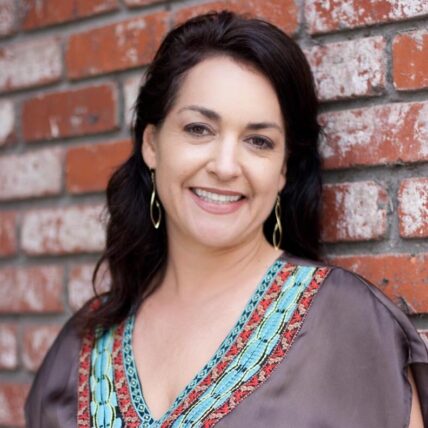
Aja Couchois Duncan (she/her/we) is a San Francisco Bay Area-based leadership coach, organizational capacity builder, and learning and strategy consultant of Ojibwe, French, and Scottish descent. A Senior Consultant with Change Elemental, Aja has worked for 20 years in the areas of leadership, equity, and learning.
Header image credit: Taylor Wright
Originally published at Change Elemental

Network Weaver is dedicated to offering free content to all – in support of equity, justice and transformation for all.
We appreciate your support!
donate in the box above or click here
The Complexity Spectrum
Systems change is not for everyone, but making a good choice is
Philanthropies are increasingly becoming key players in the field of systems change. As organizations grow more innovative and risk tolerant, they are logical partners to those working to shift systems for the better.
In addition, the work many philanthropies are doing to reckon with drivers of inequities and racism — which very often contribute to their accumulation of wealth — requires many of the same changes that systems work calls for. In fact, breaking the deeper patterns that drive racism is itself a system change effort.¹
Systems change, however, requires philanthropies to operate in ways that are often unfamiliar, even counter to traditional ways of working. While we all need to see the world through a complex systems lens, systems change is not an approach that every philanthropy can responsibly pursue.
Clock vs. Cloud
Systems change is a “cloud problem” that exists in a world built for “clock solutions.”
The clock vs. cloud (or complicated vs. complex) distinction is based on the insight that most challenges lean toward two distinct types:²

These two types of problems require two fundamentally different approaches:

Like most organizations, philanthropies traditionally focus on a clock approach: solve problems, fix what’s broken, and get it done as quickly as we can. But that’s not how systems work:
- Systems don’t get solved. At best, we hope to shift systems to a healthier state.
- Systems don’t just need things fixed. They need healing — healing of relationships, historic inequities, destructive patterns, and the environment.
- Systems are infinite. There is no finish line that can be crossed in days or even a few years. Maintaining healthy systems is an ongoing task.
Damage can be done when we try to fix what needs to be healed or think we can solve that which is unsolvable. Rather we must apply the appropriate approach to the type of problem being addressed.
“We shouldn’t try to fix what needs healing or heal that which can be fixed.
- Dr. Failautusi (Tusi) Avegalio, University of Hawaii
Philanthropies interested in pursuing system change should avoid thinking of mission in terms of solving problems — or worse, thinking they can fix in a matter of months or even a few years that which needs healing. In contrast to a mission statement that is some form of “we exist to solve the world’s biggest problems,” systems change needs a different formulation. Something like:
As a philanthropy, we make good use of our resources to support the well-being of people, relationships, processes, and ecosystems as they grapple with complex and dynamic challenges.
Why “good use” instead of “highest and best use?”
Philanthropies often think being good stewards of their resources means putting those resources to their highest and best use. But highest and best is an impossible standard when dealing with the uncertainty and unpredictability of cloud problems. Moreover, highest and best implies an expectation of perfectionism which, while a conceivable aspiration in the clock world, can be counterproductive, even destructive in the cloud world.³
Why “support the well-being” instead of “solve problems” or “create impact?”
As outsiders, as opposed to those living in the system, a system is not our problem to solve. In cloud environments, change often takes time and has multiple influences and repercussions. Tying something you did to a specific, sustainable, and systemic impact is nearly impossible.
Why “people, relationships, processes, and eco-systems?”
These are the sources from which system change emerges. It takes a system to change a system. Lasting change is more likely to happen if those in the system, as well as their relationships with each other and with the wider environment, are healthier.
A Spectrum of Choices
The goal in exploring systems change for philanthropies is not to argue that everyone should be doing this type of work. The goal is to help philanthropies make good choices about how to use their resources (financial, people, social, network, etc.)
The choice of systems change is not a binary one. Rather there are distinct types of problems and interventions that exist along the spectrum from clock to cloud.

To illustrate the Complexity Spectrum, take the issue of houselessness:

The key to understanding the Complexity Spectrum is understanding differences in clock and cloud problems and approaches. The defining characteristic of a cloud approach is that it targets the underlying patterns of behavior that make up a system and drive the outcomes the system produces (e.g. underlying patterns that drive levels of poverty and make it difficult to “fix” the impacts of poverty like lower life expectancy, increased stress levels, etc.) If an approach aims to just lessen the extent of a problem or ameliorate the impacts of it, it’s more clock than cloud.
The murkiest part of the spectrum is the difference between Solution at Scale and System Innovation. This can be confusing because the same tactic can be a Solution at Scale or a System Innovation depending on how it is implemented. Take for example Housing First in Salt Lake City and Calhoun County, MI.
In Salt Lake City, Housing First was used to remedy the problem of the chronically houseless, defined as houseless people with histories of substance abuse or mental illness. As a Solution at Scale, it was effective. Chronic houselessness was cut by 90% for the target population over a ten-year period.⁴
This success was hailed as an example of how Salt Lake City had solved houselessness. But over the same period, the number of people living in houseless shelters doubled. Why? The program was designed to solve a widespread need among a portion of the city’s houseless, but it was not designed to address the many complex and interconnected forces that drive houselessness and make it difficult to emerge from.
In Calhoun County, in a project supported by noted systems change practitioner David Stroh, they asked a different question. What was keeping the network of actors in the houseless system (providers, houseless, government, advocates, community groups) from being more effective at dealing with houselessness? They found these actors were being incentivized by a variety of sources to choose short-term fixes to houselessness rather than work on the more complex reasons driving houselessness in the first place.
The key actors in the system worked collectively to interrupt the pattern of short-term incentives and create a new pattern of relationships and processes by which they would work to deal with houselessness. They too started with the Housing First program, and it was effective. But Housing First was an outcome of a System Innovation approach — it changed key relationships and patterns that drove houselessness in the County.⁵ When the Great Recession of 2008–2009 hit, levels of houselessness did not spike even as there was a major loss of jobs in the area. In this case, a key pattern in the system changed and, as a result, the problem of houselessness was also changed.
Note the type of activity can be the same in a Solution at Scale and System Innovation. The difference is that System Innovation targets a persistent pattern (the incentive structure). The choice of Housing First in Calhoun County was a result of changing that pattern. Conversely, as a Solution at Scale, Housing First in Salt Lake City was used as a direct intervention and did not aim to change the underlying patterns driving houselessness in general. In this case, Housing First succeeded at meeting the needs of a significant population, but it did not change the system itself.
So what’s the main distinction between System Innovation and System Transformation? A system has interconnected patterns that drive the system and its outcomes. A system can have any number of patterns, depending on how deep one wants to go in understanding the system. System Innovation targets one or two of these patterns and its success depends on whether changing a specific pattern is sufficient to create a sustainable, positive change in the overall system. System Transformation, on the other hand, aims at changing the system itself by changing multiple patterns as well as how those patterns affect each other. So the key difference between System Innovation and Systems Transformation is the number and extent of patterns that are being affected.
Making a Good Choice
As the houselessness example portrays, challenges have both clock and cloud dimensions and have the potential for Targeted Solutions, Solutions at Scale, System Innovation, and System Transformation. The point of the spectrum is to show us that, in every situation, we have a choice as to where and how to engage.
Systems change is not right for everyone nor is it necessary for every problem. While the renewed interest in systems change is promising, it has a downside. The popularity of systems change almost certainly means that people and organizations are choosing it when they shouldn’t. They may lack the capacity to do the work, or only do it because they feel it’s what’s expected. Or worse, they may label an initiative as systems change when it isn’t.
Making a good choice is a function of three critical ingredients:
- Your Mission and Values. The expression of who you are, what you care about, and how you want to be in the world
- Your Capacities. Skills, relationships, practices, structures, and mental models at multiple levels (individual, organizational, network)
- Your Context. The ecosystem in which the challenges you care about exist and that affects how they may change into the future (e.g. people, structures, attitudes, narratives, trends, patterns, the natural and built environment, etc.)
Ideally, an organization aims to find the sweet spot where mission and values, context, and capacities align; a particular approach will allow you to effectively serve your mission in a specific context using your distinctive capacities.
Let’s take a hypothetical organization whose mission is to reduce houselessness in a major US city. Assume that organization takes a system-level view of what drives houselessness in their community. As noted above, they are likely to find some version of each of the four challenges (urgent needs to a complex system) and the potential for the four approaches. But assume their analysis also shows:
- The system overall is moving in a positive direction and many novel and promising approaches are emerging.
- Recent policy changes mean there are many new benefits for those in or emerging from houselessness, but there are many obstacles to applying for and receiving those benefits.
- This “benefits gap” creates a widespread need among the houseless.
- There is still uncertainty whether these emerging trends will continue in a positive direction and if policy changes will help, or if old patterns that drive houselessness will re-emerge.
- There are still many houseless who will face urgent needs for shelter when the weather turns cold, and there are many chronically houseless who are still underserved.
The organization is tech savvy, has strong capacity in product development, and solid relationships with local government and houseless providers. They do not have experience in doing systems change explicitly and lack the monitoring and evaluation capacities that highly adaptive system change work requires. And because the organization found solid indicators that the “houseless system” in their community is generally moving in a positive direction, they saw less of a need for the organization to invest in some form of systems change (Innovation or Transformation).
They decide their resources would be best used in pursuit of a Solution at Scale — an app that connects houseless and providers with benefits and simplifies the application process. But they will need to monitor whether urgent needs in the system will grow and make longer-term work much harder, or whether old problematic patterns will re-emerge and potentially undermine even an effective Solution at Scale.
Governing Amidst Complexity
The Complexity Spectrum and the mission-context-capacities framework are designed to help make a hard choice a bit easier — but it is still a difficult one. Of the three variables, capacities pose the biggest challenge:
- Your mission and values are in your control. While they may be ill-defined or out-of-date, you still have control over them.
- Understanding a complex system is difficult, but it is still possible. There are a wide range of systems and complexity tools and practices for sensing systems and how to engage them.
When it comes to capacities, however, I am not aware of any organization pursuing system change that feels they have it all figured out. In fact, I’m certain they never will — because systems are dynamic, as are the capacities needed to engage systems.
Philanthropies, like most organizations, will take time to become agencies of system change. Effective governance — the ability to make a steady stream of decisions in the face of complexity and outside of just the board room — will allow philanthropies to become effective contributors to system change efforts. Governance, in service of being agile and adaptive, is the key capacity that philanthropies must develop to be effective at system change. The next blog in this series will explore this idea further.
* * *
Note on definitions: the use of the term “system” in this piece refers to an aid for learning or discovery — a helpful way to understand reality. In particular, the word system here refers to a complex adaptive system, meaning it is ever evolving and made up of many patterns of behavior that persist and change over time, and which interact with and affect each other. In this sense, system, as used here, is not a real thing; it is a mental model. A complex adaptive system, as used in this piece, is distinct from seeing just the tangible elements of a system (e.g., seeing a healthcare system as consisting of patients, providers, insurers, first responders, nurses, doctors, regulators, etc.) versus seeing the dynamic patterns that drive the level of health in a community (e.g., a poverty trap where people who are poor can’t afford sufficient healthcare; but because their health suffers, their earning potential is limited). The theory behind using the complex adaptive system is that understanding patterns of behavior and affecting them is the way to change such systems over time.
[1] See Systems Change & Deep Equity: An Interview with Sheryl Petty and Mark Leach; And the work of Jara Dean-Coffey and the Equitable Evaluation Initiative; Also Dean-Coffey, J. (2018). “What’s Race Got to Do With It? Equity and Philanthropic Evaluation Practice.” American Journal of Evaluation, 39(4), 527–542.
[2] Clock-Cloud are terms coined in the 1960’s by Karl Popper; Complicated-Complex have been described by Dave Snowden (in the Cynefin Framework) and Brenda Zimmerman.
[3] Okun, T. “white supremacy culture.”
[4] Hobbes, M. “Why Can’t America Solve Homelessness?”
[5] Stroh, D. P. (2009). “Leveraging Grantmaking: Understanding the Dynamics of Complex Social Systems.” The Foundation Review, 1(3). 109–122.

Rob Ricigliano is the Systems & Complexity coach at The Omidyar Group, where he supports teams as they engage complex systems to make societal change.
originally publshed at In Too Deep
featured image by Wolf Zimmermann on Unsplash

Network Weaver is dedicated to offering free content to all – in support of equity, justice and transformation for all.
We appreciate your support!
donate in the box above or click here
The role and power of re-patterning in systems change
7 everyday patterns to shift systems towards equity
Many recent discussions about civic innovation and systems change have focused on big structural changes that need to take place if we are to grow more equitable outcomes. Along with our friends at TSI / Auckland Co-Design Lab we suspected that we also needed to explore what could happen underneath those structures at the level of more fundamental and ‘everyday’ values, mindsets, behaviours and interactions.
Our combined piece of work began with the hunch that ‘there are already patterns of change that exist and are emerging’. Maybe there were pockets of the future that already exist in the work we were doing that could help transition systems towards equity?
This series on patterns is the culmination of this exploration. We offer it as a demonstration that shifting systems towards equity is possible and that it is the responsibility of everyone to start doing and being differently, in every part of every system, every day.
It introduces seven patterns we have identified across the work of TSI in South and West Auckland that go some way to making visible, active re-patterning for equity and power sharing. This blog and the full PDF introduce the series, and we will release more detail on each pattern over the next couple of months.
First — what’s a pattern in the context of systems change?
In simple terms, patterns are interconnected behaviours, relationships and structures that together make up a picture of what ‘common practice’ looks like and how it is ultimately experienced by people interacting with and in a system.
If we take Public Services in the twenty-first century here are some examples.
Public Service organisations have most often been formed around concepts such as universal access, service delivery, social safety nets, and public provision of critical infrastructure. Built into these elements are patterns, like:
Patterns of relationships: based on objectivity, universalism, professional relationships.
Patterns of resourcing: focused on rationing, efficiency, programmatic resource flows.
Patterns of power: centred on professional expertise, needs assessments, deserving access to spaces and services.
On the surface, these are not necessarily negative and there have doubtless been many successes enabling broad access to services and infrastructure.
It’s also true though that there remain many who have not benefited, who have missed out on access or opportunity, and who have actually been harmed by and within the system.
What is needed is a foundation for public systems that moves away from goals of access to more and better servicing of communities, and towards goals around learning how we can promote patterns of thriving, aspiration, success and ‘wellbeing’.
The role of everyday patterns in shifting systems
There are a growing number of people discussing the need for systems in many circles — from service providers, funders, investors, intermediaries, and policymakers.
As noted above, most of these discussions focus on the big-picture tasks of pulling various levers from policy changes to new program design.
However, in our work alongside public servants, we have found it just as important to focus on how we shift the foundational patterns, behaviours, relationships and interactions that underlie all parts of systems.
The everyday patterns.
These may look small in the scheme of systems, but actually, they can fundamentally shift people’s lived experience of systems. And importantly — they are within the reach of every one of us who works in a system to start to learn our way into.

Becoming pattern learners to re-pattern systems
If we’re interested in systems transformation we need to become pattern learners.
Humans are extraordinarily good at recognising and responding to patterns. They have always helped us understand, navigate, make sense of and respond to the world around us. Every pattern — every interaction within a system — can reflect the values embedded in that system. So, if we want to change systems, we need first to observe or at least begin to understand the patterns underpinning it. We also need to imagine, learn, test and spread new patterns in order to affect change.
The patterns we present here provide a glimpse of transitioning to more equitable, just and healing systems. They have been developed in a context and are still more like starting points than fully developed patterns of good practice. We see them as prompts that help us to learn, make sense and meaning and deepen dialogue about what it may take to truly create transformed systems for wellbeing in equitable and just ways. We share these patterns to foster collective dialogues about how we can shift systems towards wellbeing, where people and places can flourish rather than just survive.
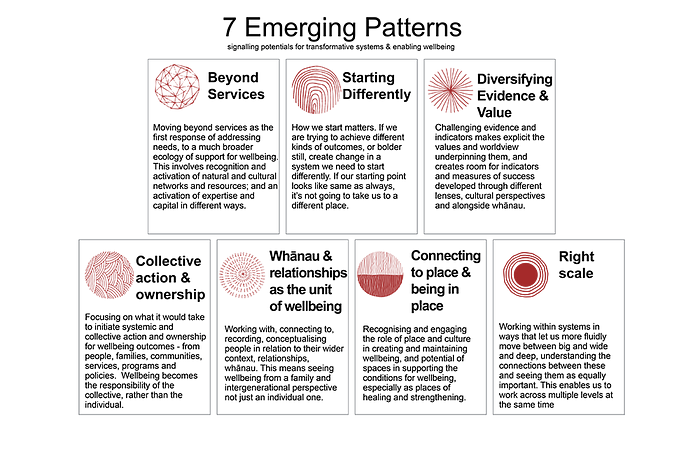
Over the next couple of months, we will share deeper dives into each pattern, culminating finally in a combined piece of work.
Read the first deep dive: Beyond Services
Read the second deep dive: Starting Differently

The Yunus Centre at Griffith University exists to accelerate transitions to regenerative and distributive futures through systems innovation
Originally published at Medium
featured image found here

Network Weaver is dedicated to offering free content to all – in support of equity, justice and transformation for all.
We appreciate your support!
donate in the box above or click here
Turning the stone: embedding systems thinking in the everyday
The context
Images
Isn’t it interesting how frequently as human beings we turn to metaphor? Sometimes these images are so embedded in the everyday that we don’t see them for what they are. We talk about ‘just ploughing on’, ‘turning over a new leaf’ and much more. Why? Because we don’t feel, think and communicate solely in mechanistic term, we are not ‘desiccated calculating machines’. We think in patterns, through resonance, emotion, stories and intuitive connection as well as logic.
Metaphor evokes in us things the literal cannot. It uses the poet’s deftness to reduce the messiness of the world, rejects the technocrat’s straight line sketch of reality. Metaphors also offer shortcuts to submerged mental models or situations, containing in their DNA bundles of previous inter-related experience and learning. I find images can be useful touchstones or motifs around which to organise my thoughts or re-centre activity or purpose. ‘Be more water’ etc.

Systems
Given this, it’s not surprising that imagery and metaphor feature heavily in systems thinking.
Over the past six months I’ve been learning about systems thinking approaches as well as systems change — their practical application in the cause of social justice or similar ends. I’ve been exposed to an intoxicating array of philosophies, tools, narratives and claims. Inevitably some have resonated more strongly than others. A couple I have found a bit vague (but probably didn’t understand) and a couple I have found a bit opaque (and definitely didn’t understand).
But the process of learning has been quite liberating. It has given me new ways to think about the universe I exist within; who can ask for more than that?
Imagine if a toolkit existed which allowed you to pick the lock of whatever complex policy or operational challenges you were dealing with that day. But also somehow captured the shifting beauty of a thousand starlings in flight or the majesty of the moss covered forest-as-organism. Something that gave definition and structure to all the intuitive system-craft we develop simply by being tenacious and creative in our work. That to me is the appeal of systems thinking.
Systems change in the everyday
Some of the approaches I have come to know take hard work, safeguarded time and the willing collaboration of colleagues. Others flit around at the paradigm level, triggering unconscious mindset micro-recalibrations. The variety is at times overwhelming.
So when I asked myself what artefact I wanted to produce to mark the end of my School of System Change Basecamp programme I thought I would consider practical ways to weave embed systemic practice into the everyday.
After reflection I concluded first one thing and then another. Firstly, that identifying and developing the mental and behavioural pre-conditions which allow systemic thinking to flourish is probably more important than striving to develop deep technical understanding of specific tools — after all no plants will grow in a barren field, no matter how packed with potential the seed. And secondly that I wanted to use emblematic metaphors to pin down the most important of these core attitudes, from which a number of simple, everyday systemic practices could then flow.
So the three sections below are a simple — and imperfect — attempt at that. Three images to lodge in my head, and perhaps yours too.
The images

Turning the stone
I have a memory as a child of turning a large flat stone in a wood and becoming enthralled at the universe-in-miniature beneath it. Insect life, leaf mulch, moss. The dynamic equilibrium of decay and fertility, death and life.
Although it’s impossible to pin down what systems thinking/change represents to any single person, for me it is a world-view build on a deep curiosity about the universe and our place in it. It’s hard to be open to other standpoints, learn or develop without an open mind (and an open heart too). A sense of ongoing intellectual and social inquiry can turbo-change any job which requires tactical relationship building, political weather reading, policy landscape navigating and hard decision making.
Ways to turn the stone:
- Deliberately immerse yourself in media and news sources you know you’ll disagree with. Take time to mentally articulate why you disagree with the arguments and be wary of jumping to conclusions. This is actually quite hard to do! The voluntary sector in the UK, for instance, has an obvious bias towards the soft left politically but I hear few people challenging the system to actively seek out opposing views and force the remaking of arguments for the full range of world-views. If you find your ideas shored up by the process that’s great — like a vital aircraft component that’s been stress-tested to near destruction in the workshop it is now ready for use in the outside world. However you may find your ideas slowly changing — it’s all part of ‘exposing your mental models to the light of day’ (Donella Meadows). [ap_spacing spacing_height="5px"]
- ‘Get the beat of the system’ (DM again) — set up a rolling meeting with an inter-disciplinary cast representing the most obvious system viewpoints around which you are working. Or convene a space with four or five experts from the same discipline. Get a monthly Zoom/Team invite in the diary and the admin load is light. Help set the tone and model behaviour at the beginning then sit back — see what people bring. It’s amazing the insights, thoughts, ideas (and yes rants) people share, once they are convinced of the fact they are within a group of trusted system colleagues, outside the more formal spaces of government forums and rigid agendas. Sometimes this more explorative space may feel unfamiliar so you may need to sell it as an informal advisory group of some kind. Convening isn’t about just ‘doing the admin’ it’s about setting a tone, making people feel valued and respected, ‘holding the space’ and modelling behaviour that you wish to see others exhibit.

Building the spider’s web
There are three basic elements in any system — data points (people, perspectives, organisations, cells, trees), the connections between them and a uniting, animating purpose. My observation from policy work is that too much attention is paid to the things themselves and not enough to the connections between them.
Building a network of contacts — and entrepreneurially convening flexible spaces within it — may again allow you to get the beat of the system and develop a more richly detailed (though still partial) map of the territory. A fancy name for this might be ‘distributed cognition’, but I think of it as building a web.
Ways to build the web:
- At the most simple level it could be consciously focusing on the relational. Almost all roles and ways of exploring the world involve working with and through others so relationships are obviously key. Systems leadership across organisational boundaries is impossible without high-quality, sticky and trusting relationships. These will support all future work from developing shared campaign positions to negotiating the finances of a major joint operational undertaking. Thinking of relational work as the work and not just a means to doing the work might help.[ap_spacing spacing_height="5px"]
- If getting into systems change feels a bit like joining a secret society then it follows that you must identify and cultivate your fellow travellers. They will not appear according to rank, status or job description. Some will be formally trained and others not. Carving out space and time is key here, which is why I’ve started some thinking about a systems change learning club with an emphasis on the fun, informal side of systems exploration.

Looking into the pond
Knowledge of self precedes almost all other forms of knowledge. The wisdom of the ages tells us that we must know ourselves before turning to identify problems and solutions in the external world — ‘physician, heal thyself’.
There is no two ways about it — to work systemically is to work reflectively. The whole idea is about taking a step back and what is that other than an instruction for reflection?
The image of a still pond reveals itself to me here. Mirror-like, but not a mirror. A surface broken by debris, imperfectly reflecting a face.
Ways to look into the pond:
- Building simple reflective practice into the everyday. Do you have a key series of meetings or a super important stakeholder relationships to develop? Or perhaps a colleague you are struggling to get on with? Or a knotty policy issue dancing before your eyes? Try journaling. Don’t overthink it, use a physical journal or a note-taking app like Evernote to get some stuff down. This is usually about the wisdom of the moment so try to do it immediately after the event rather than in hindsight (when our brains begin to impose post-hoc rationalisation). I remember doing this after my first board meeting and breaking it into ‘head’ and ‘heart’. The first covered the mental and bodily experience of a potentially stressful situation, the second provides analytic commentary on how events unfolded and how things could be different next time.[ap_spacing spacing_height="5px"]
- The pond does not reflect just the individual but the system itself. One of the School for System Change’s systemic practices — which I love — is ‘enabling the system to see itself, hold the whole picture’. Think about the causal chains that (nominally at least) link the key data points within the system you are working on. For me it might be something like: minister is keen on a policy, directs senior officials; officials develop policy framework; resource devolved to local government level; commissioner commissions provider; provider CEO sets out a vision; ops director mobilises a service; practitioners make the magic happen for people in recovery; person in recovery volunteers as peer mentor. (You can make it more or less detailed as you see fit.) Now typically most data points (people in this instance) are familiar with only their neighbouring one or two points but much less so with the ones further up or down ‘the food chain’. Short-circuiting those connections can have powerful results. I recently organised a trip for a very senior civil servant who had taken on the treatment and recovery brief. We brought him, and other officials, to a recovery service in North London to listen and learn from senior public health representatives, local government commissioners, frontline workers and people in recovery. And in that room in Tottenham the system was presented with a mirror and — fleetingly — could see itself and understand its shared purpose. The officials walked away remembering that policy-making is not an end in itself but an embodiment of the social contract in action; communal resource being deployed to high quality create public services. The frontline workers walked away feeling that policymaking at the centre is hard, but has good people attempting to address that hardness. Things click into place. ‘Ah, I get why that join up with criminal justice doesn’t work properly, as you’ve had your budgets hammered’. ‘So that’s what assertive outreach is, I had always wondered’. ‘So which agencies should we try and bring together at a local level to provide accountability back to the centre?’ ‘I can see it now, this is why we do what we do — communities improved, families healed, citizens recovering connection and meaning’.[ap_spacing spacing_height="5px"]
- Finally I hope the pond will reveal the embedded nature of our locations within multiple overlapping systems. And the see-sawing of feelings this realisation brings — greater understanding, identification of allies and experience of positive change delivering hope and a potent sense of agency on the one hand, awe at the scale and intricacies of the systems which shape the problems we wrestle with delivering a sense of hopelessness on the other. It might be daunting but we are part of it. As one of my co-learners brilliantly put it: ‘I am the system; we are the system’.
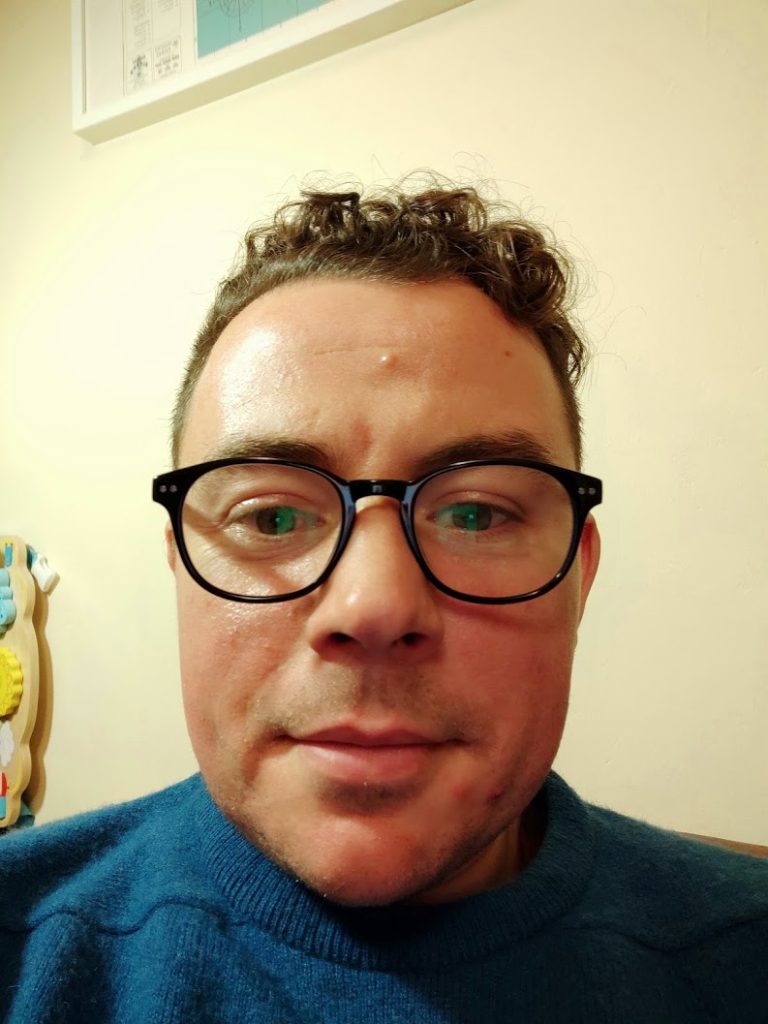
Oliver Standing is Director of Collective Voice, the national alliance of drug and alcohol treatment and recovery charities. He is responsible for its day to day leadership and delivery of its main activity – policy and advocacy work to help bring about an effective, evidence-based and person-centred support system for anyone in England with a drug or alcohol problem. Collective Voice also shares good practice and brings together networks across the sector.
Before this Oliver worked for Adfam (the national charity working to improve support for families affected by drug or alcohol use) for eight years, latterly as Director of Policy and Communications. He has a deep interest in systems change, having taken part in the School for Systems Change Basecamp for Health Leaders in 2021, with a particular focus on policy-making in complex environments and driving collaboration across organisational boundaries. https://twitter.com/OliverStanding
originally published at School of Systems Change

Network Weaver is dedicated to offering free content to all – in support of equity, justice and transformation for all.
We appreciate your support!
donate in the box above or click here
Decentralized organizing: More collaboration, less hierarchy
From organisational governance to mobilising and sustaining grassroots movements, what is decentralised organising and how can this approach facilitate collective but efficient decision-making without management hierarchy?
Decentralised organising isn’t just about delegating tasks and responsibilities. It’s about transparency and openness, including how financial decisions are made and how labour is divided. This approach creates a great work ethic:
- Empowering members to do the work they care about, not just what they’re told to do
- Cultivating a culture of trust, collaboration and transparency
- Incentives are aligned because ownership is open to all
Sounds good? We recently caught up with Rich and Nati from Loomio while they were in London and discussed some useful decentralised organising approaches. Here are some changes you can easily implement to start working more collaboratively with less hierarchy:
Establishing “ground rules”
Norms are informal agreements about how group members should behave and work together, e.g. open, honest, inclusive. Boundaries are behaviours that we want to exclude, e.g. no mean feedback, exclusionary decision-making. Collectively, norms and boundaries can also be referred to “ground rules”.
Take time to listen to each member’s perspective. Then, as a group, decide on what your shared norms and boundaries will be. Finally, have this documented and accessible to all members and new members so that expectations are clear and transparent. This way everyone is bound by the same ground rules.
Communication norms
Open but efficient communication is a cornerstone of successful and strong relationships. It can be built by establishing communication norms and collectively agreeing on what communication tools to use for what job. For example:
- Realtime: like whatsapp chat: Informal and quick, it’s about right now.
- Asynchronous: Email or Loomio. More formal, organised around topic. Has a subject + context + invitation. Can take days or weeks.
- Static: Google Docs, Staff handbook, or FAQ. Very formal, usually with an explicit process for updating content
An understanding of when to use different communication tools avoids clogging up communication channels with unnecessary information. Finally, it is important to support members to learn how to use tools and remind each other gently to build habit.
Sharing is caring
Hierarchy habits such as having the same chair for team meetings can discourage other members to feel that they can bring ideas forward, participate in decision making, and take leadership. It is important to be intentional about the behaviours you want to bring to your organisation or network so that members trust each other and feel comfortable working together:
- Intentionally produce a culture of trust and belonging by sharing power, enabling lots of time for discussion, for natural leaders to be reminded to hold back and let others talk,
- Growing collaboration skills with practice through empathy, reflection and communication. It helps to have 5 mins reflection at the end of the meeting to ask people how they think it went – OR send out an anonymous reflection form just after the meeting to see how it performed against the organisational values.
- Distribute ‘care’ labour: make care work visible so that it can be fairly shared – this includes things like organising biscuits to setting the agenda.
Decentralised organising in practice: The Lambeth Portuguese Wellbeing Partnership
In this next section, we feature the Lambeth Portuguese Community Wellbeing Partnership (LPWP), a grassroots community network of over 40 local groups and community members. Bringing together organisations and people from across the health, social, charity and voluntary sectors to listen and work together, the LPWP is an exciting example of working in partnership through decentralised organising to help the Portuguese speaking community live healthier lives and to remove the barriers they face accessing health services. The partnership are keen to work towards adopting a decentralised organising approach and are on a continuous journey to work towards greater transparency and collaboration to create change.
Their successes and impact so far include
- A Breakfast / Homework Club run in conjunction with a Portuguese Café, a local school, educational charities and the NHS.
- A GP surgery and a voluntary sector organisation carrying out joint assessments of frail and vulnerable patients, with the voluntary community liaison officers providing care-coordination and links into social support.
- End of life and Latin American disability charities working together to modify advance care planning templates, empowering those at the end of life to make the decisions that are important to them.
- Culturally relevant patient leaflets, education videos and an NHS ‘Welcome Brochure’ in Portuguese, informing patients of their NHS rights and self-care options.
- A children’s charity working with scientists, to provide children from vulnerable backgrounds experiences working in science in universities.
The LPWP commissioned the Social Change Agency to support developing a strategic and decentralised organisation framework that will ensure that the partnership can play an active role in helping people with multiple long-term conditions live fulfilling lives for longer. It was a great pleasure to meet and interact with some of the organisations and individuals within this partnership, their passion and commitment to working together through values that include inclusivity and trust to improve the wellbeing of Portuguese speakers in Lambeth is truly inspiring!
If you want to focus was on moving towards flatter hierarchies, grassroots decision-making, and letting go of traditional hierarchies, then get in touch to find out how we can help.

The Social Change Agency is an expert team of strategy consultants, campaigners, communicators, and governance geeks. They’ve launched powerful movements, built innovative networks and led groundbreaking campaigns - their expertise spans every aspect of social change.
originally published at The Social Change Agency

Network Weaver is dedicated to offering free content to all – in support of equity, justice and transformation for all.
We appreciate your support!
donate in the box above or click here
Pattern spotting: a core practice for systems change
I find pattern spotting deeply satisfying as a practice. It helps me work with complexity rather than trying to simplify it, it reveals rhythms and structures that can support deep change work, it awakens my curiosity and creativity and quietens my rational brain’s constant quest for answers. At best it reminds me how much the world we live in is alive, and brings a 60s wallpaper sort of joy to very challenging work.
In systems change work, the term “pattern” comes up a lot. We refer to “pattern spotting” as a practice that can help understand the dynamics that characterise a complex system. We ask about “patterns of behaviour” and how to explore their deeper causes. We can even define systems change as “the emergence of a new pattern”, as an outcome where the “pattern of a system has changed”.
However, working with budding and seasoned systems practitioners over the last few years has led me to believe that we are not all putting the same thing behind this magic word. My unsatisfactory attempts to translate it into French (I live and work in the South of France) have also shown how much can be conveyed by this one word. If we want to collectively develop this practice as an effective way of understanding and engaging with systems to create change, we might want to delve a bit deeper into the multiple meanings of “pattern”. This article is an attempt to do that by bringing some structure to the way we think about pattern in the context of systems change.
Systems change pattern spotting: from two dimensions to four dimensions
Pattern recognition is a core ability of the human brain, and that of other animals, whereby information received from the environment — through all the senses — enters the short-term memory and is compared with content stored in the long-term memory. Finding similarities between what we experience now and what we have experienced before enables us to process huge amounts of information in an effective way; we do not need to analyse every piece of data because we can rely on patterns to understand what is happening and what is likely to happen next.
Pattern recognition is necessary for understanding language, recognising people we know, enjoying music and art, engaging in logical thinking and reasoning. This ability draws on several different cognitive processes which allow us to engage with the complexity of the world around us. In this article I am not sharing content around these cognitive processes (Wikipedia is a good starting point for this), but rather a way to think about how we use this ability in systems change work.
I am proposing a structure for exploring “pattern” that is based on our understanding of dimensions. This has helped me tease out some subtle differences system change practitioners are referring to when they speak about pattern spotting. As always, the framework I propose here — from two dimensional to four dimensional patterns — is not a description of reality but a way to engage our visual and geometric cognitive capacities when working with complexity.
Starting with 2D
When thinking of patterns we often think in two dimensions — a motif repeating across a flat space, such as a pattern on a wallpaper. As facilitators of change processes, we might also use two-dimensional pattern-spotting in a conversation or workshop setting when we’re looking to cluster ideas, matching like with like. Here although the setting is alive and three dimensional, the way we’re playing with pattern is effectively in a ‘flat’ space as we organise components into clusters of similar content, or along a spectrum with two polarities.
This is a great skill to strengthen when looking at the world: natural forms are brilliant for repeating patterns, and graphic designers generate wonderful visual shapes in wallpaper and typography. Mathematical patterns can also be a way to explore what I’m calling two-dimensional patterns, looking at sequences of numbers and finding the way they’ve been designed. Or exploring geometric patterns and shapes
However, this is just the starting point for recognising patterns in systems.
Moving to 3D
Beyond this two-dimensional focus, we need to layer on the ability to see patterns across scales and contexts, to work with the interconnected and complex nature of the world. We can understand the living world as being fractal, with shapes that repeat across scales like a fern leaf.
adrienne maree brown has a chapter on fractals in her book Emergent Strategy, Shaping Change, Changing Worlds (2017). She invite us to
“Tune into the prevalence of spiral in the universe — the shape in the prints of our fingertips echoes into geological patterns, all the way to the shape of galaxies. Then notice that the planet is full of these fractals — cauliflower, yes, and broccoli, ferns, deltas, veins through our bodies, tributaries, etc. — all of these are echoes of themselves at the smallest and largest scales.” (pp51–52)
So when exploring systems, we look for core patterns that are showing up across scales. We ask questions such as “How is what is going on at a small level in my team, in this organisation, mirroring or reinforcing a problematic characteristic of the wider sector we’re part of?”
This can be trickier than finding 2D patterns because it’s often harder to see polarities or similarities when we broaden the boundaries within which we are inquiring. Things that might feel quite materially different because of scale — user experience of getting on a train, where people coming from all over the city converge in a station and then get filtered onto their respective trains, with ticket barriers etc. and the organisation of the train network at a national level where regional services converge on big cities and often on the capital in a “all roads lead to Rome” pattern [check this example, centralised energy might be another interesting one] — can be understood to have a fractal quality. To see this, we need to practice being able to ‘zoom out’ and look at more complexity, while holding onto a pattern we’ve identified and are familiar with when we ‘zoom in’.
We might also start looking for patterns across different contexts within a given system or challenge. For example, I worked with a team looking at how to foster more collaboration with groups involved with marine conservation and the definition of priority marine conservation zones. After a lot of thinking about barriers to collaboration, as a group we identified a pattern that was showing up across the piece. The government process for engaging diverse local stakeholders around marine conservation issues was essentially extractive: asking for insight that then just got fed into an opaque decision-making process where the local people had no agency. This mirrored the wider relationship to the sea as a whole, equally extractive — people extracting fish, dredging up sand for the construction industry, thinking of the sea as a leisure space — where the sea’s intrinsic agency as a living system was not brought into the equation at all. Identifying this pattern between the wider issue of our relationship with the sea, and the governance culture and process in place around marine conservation, opened up avenues for creative thinking about how to seed positive change.
Exploring 4D
We have looked at two and three-dimensional patterns, and yet when we are doing systems change work we also need to stretch to four dimensions — to include patterns and change over time.
One big difference between wallpaper and patterns in the living world is that the former, despite some psychedelic motifs that might seem to move, are static, whereas the latter are in constant motion, changing over time. This is essentially because they are relational. If we move beyond the wallpaper pattern seen as an image of forms organised in a certain way on a flat surface, to ask ourselves which relational patterns it is involved with, things come alive: crazy 1960s wallpaper consistently make me smile, and consistently make my mother cringe (which then makes me smile!). These are the patterns of systems change — dynamic patterns of behaviour in the world. Donella Meadows shares the importance of looking for these:
“Systems fool us by presenting themselves — or we fool ourselves by seeing the world — as a series of events. […] We are less likely to be surprised if we can see how events accumulate into dynamic patterns of behavior. […] The behaviour of a system over time — its growth, stagnation, decline, oscillation, randomness or evolution. […] When a systems thinker encounters a problem, the first thing he or she does is look for data, time graphs, the history of the system. That’s because long-term behavior provides clues to the underlying system structure. And structure is key to understanding not just what is happening, but why.” (Donella Meadows, Thinking in systems: a primer, 2008, pp88–89)
Pattern recognition as a cognitive ability is developed in order to predict what is going to happen next through remembering associations of events in the past, so we can flow with what is going on. With systems change work, we are not only looking for patterns of how things are predictable and repeat, but also how things are changing — what is the pattern of change? We think about how things have come about to be the way they are, and what relational elements are affecting how change is happening.
Systems change practitioners often invite us to look at the interactions between different forces to deepen our understanding of the patterns of change. Here are a few of the ways I have learnt to develop this practice of what I’m calling 4D pattern spotting, alongside practitioners we work with at the School of System Change.
Interacting patterns of structure and process
Bill Sharpe’s “holism with focus” exercise from his book Three Horizons: The Patterning of Hope (2013) has us understand the evolution of pattern in the world over time by exploring cycles of flow and structure. He invites us to look at a tree:
“What you immediately see is a structure of trunk, branches and leaves. What you cannot immediately perceive, but know to be the case, is that the tree is living and growing by drawing up water and nutrients from the ground, and capturing sunlight in its leaves to drive the process of photosynthesis. […] The structure of the tree configures the processes by which it lives, and those processes build and maintain the structures.” (pp35–36)
Tuning into the dynamic relationships between structures and processes is a core skill that is used during a Three Horizons futures process, helping us look for adaptive pathways towards a desired future.
“There is so much information around us all the time that we cannot possibly pay attention to all of it, or think about where it might lead. Only once we have tuned into a longer-term perspective and primed ourselves to see the patterns in play does the small act acquire big significance as a harbinger of things to come.” (p40)
A dance between patterns and events
Jean Boulton’s approach to embracing complexity invites us to look at the dance between patterns (established and contextual ways of being in the world, which I would call two-dimensional and three-dimensional patterns here) and events (convergent moments of change with the power to disrupt patterns). This can help us to understand and influence the non-linear evolution of systems over time. In the book Embracing complexity: Strategic perspectives for an age of turbulence (2015) we read:
“The future is a complex combination of (a) the effect of current patterns, which can be studied — at least to some degree — scientifically and analytically, and (b) the effect of particular events or variations at particular times and places. These two factors — enduring patterns and specific events — through interacting together, shape what happens.”(p31)
This is an invitation to broaden our view beyond the pattern, to the non-pattern, specific and contextual signs of other things happening: “It is the detail and variation coupled with interconnection that provide the fuel for innovation, evolution, change and learning.”(p29)
Sensing into essence patterns
Ben Haggard and Pamela Mang’s practice of regenerative development has us working to understand essence patterns that influence how complex living entities evolve and change in response to a dynamic world, while still staying true to their essence. Seeing these patterns requires us to engage with deeply contextual thinking, for example in understanding places as living systems:
“It is possible to discover the ongoing and distinctive core patterns that organize the dynamics of a given place. These core patterns are the source of its recognisable character and nature — its essence. They influence the complex relationships that produce its activities, growth and evolution. When seeking to identify these core patterns, Regenesis asks three questions: How does this place organize and renew itself? What does it consistently pursue? What value does it generate as as result?” (Regenerative Development and Design, 2016, p49)
I have tried to articulate my attempts at applying this sort of approach to living systems beyond place (see article here), and certainly find that using a pattern mind to do this is key.
Developing your pattern-spotting practice
Like all systemic practices pattern spotting is a skill to be reawoken, reframed, practised and developed all the time. I say reawoken because we all have a capacity for pattern recognition from our earliest childhood as we discover the world and the people around us, and this is something we can become more attuned to again as a way of being in the world as much as a new skill to acquire. As with all practices, we improve muchly with small daily honing of pattern spotting skills as well as (more than?) with chunky dedicated time. Here are some ways some of us at the School of System Change practice pattern spotting in our daily lives and work, with techniques and frameworks from across the field of systems change and beyond:
- check-ins where we mirror back the pattern of the whole to the group
- playing with multiple cause diagrams / causal loop diagrams, zooming out to see the deeper pattern that drives the dynamics of a system
- seeking essence pattern when engaging with new people and organisations
- visual note-taking
- learning to play music (again) and crafting playlists for online learning sessions
- writing poems, or finding poems for important learning moments
The joy of learning in a world that is becoming
For me, the joy of this practice is in the sweet spot between comfort — recognising a pattern is deeply satisfying and reassuring — and learning, sparking new connections and neural pathways. As Tyson Yunkapora so beautifully puts it: “if people are laughing, they are learning. True learning is joy because it is an act of creation.” (Sand talk, 2019, p112) He goes on to distinguish between two kinds of joy: “One is characterised by light-heartedness and the other is marked by fierce engagement and deep concentration.” For me, pattern spotting can be both: light-hearted (as in 60s wallpaper) and also a fierce engagement with what is needed from us in the world right now, for our work in systems change. As Ben Haggard and Pamela Mang write,
“An ability to discern the patterns around us is key to honoring and working with complexity. […] It is this way of seeing that enables us to engage with a world that is becoming.” (p210)
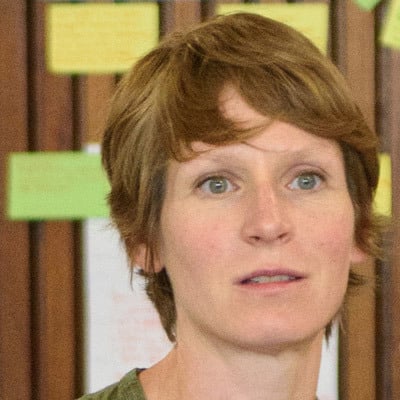
Laura Winn is head of the School of System Change at Forum for the Future. She works to develop the School as a networked organisation that supports change-makers from diverse backgrounds and contexts, providing them with new capabilities to tackle an increasingly complex set of sustainability challenges. Laura's own practice stems from living systems and regenerative approaches, learnt and applied across multiple small-scale and large-scale projects.
originally published at School of Systems Change

Network Weaver is dedicated to offering free content to all – in support of equity, justice and transformation for all.
We appreciate your support!
donate in the box above or click here
Stories that Change Systems
This blog was originally published in February 2022 by Rotary Charities of Traverse City.
“Stories make, prop up, and bring down systems. Stories shape how we understand the world, our place in it, and our ability to change it.”
– Ella Saltmarshe, Telling the Difference
In November of 2021, Rotary Charities began piloting a new service for collaborative initiatives working to solve complex community problems, systems change coaching. Coaches with varying expertise - from convening and facilitation, systems mapping, shared governance and decision making, and collaborative fundraising - have been made available to fifteen different initiatives that are taking a systemic approach to address a community issue.
Three months into the eight-month pilot, we have noticed a pattern. Nearly 70% of requests have been for guidance related to communications or storytelling. This piece explores the unique power of story in systems change work and shares some local examples of how initiatives are using story, as well as how and why initiatives remain challenged to use this tool to its full potential.
The demand for storytelling support was surprising on the surface, but after some reflection, it became obvious how vital storytelling is to the success of initiatives that are aiming for large-scale transformation. Storytelling has tremendous worth both internally to build coherence and purpose across diverse actors in a system, as well as strategically to build public understanding, empathy, and belief in the possibility of a different future.
Ella Saltmarshe in her piece, Telling the Difference: Using Story to Change Systems, frames this as the power of story to light (illuminate), glue (cohere), and web (shape mindsets).
Illuminate
Stories help us describe the current state of a problem, the systemic factors creating the problem, what needs to change, and can help us see our role in both the problem and the solution. We can use stories to amplify the voices of those with lived experience with an issue, helping us to build understanding and empathy for perspectives and experiences different from our own.
The Public Will Campaign to End Child Sexual Abuse, a partnership between the Traverse Bay Children’s Advocacy Center and Michigan State University, and one of the first Rotary Charities systems change grantees, sees story as central to their work. Early on, the Campaign’s core team designed a Storytelling Workshop and Our Stories website page for sharing common landmarks around the issue of child sexual abuse to help influence normative behavior. The Campaign also curated literature and media on their website to further illuminate the subject. They have recently been awarded a Rotary Charities Seed Grant to partner with University College Dublin to facilitate book clubs in the region and measure changes in participant awareness, empathy, and willingness to act to protect children. “Despite the prevalence of child sexual abuse, it remains a relatively taboo subject due to its intensely upsetting nature,” notes the Campaign’s former Executive Director, Sue Bolde. “Stories help to ease our ‘social flinch’ from engaging with the issue, which positively affects efforts to prevent CSA and to support survivors.”
Another systems change grantee, The Northern Michigan Community Health Innovation Region (CHIR) has recently launched an intensive focus on behavioral health and wellbeing and are using a different type of storytelling device, photographs. The CHIR was awarded a Seed Grant to recruit high school youth to take photographs that depict their perspectives and experiences with mental health and wellness, a strategy called PhotoVoice. The photos will be debuted to hundreds of practitioners and community members at an upcoming Behavioral Health Summit in April, and then will form a traveling exhibit.
Cohere
Transformative change work requires the participation of many people from different parts of a system, often with differing perspectives and experiences. Stories can facilitate the work of convening and connecting people to a shared purpose and each other. Many networks, like the newly formed Sonder, begin meetings with small group connection activities, allowing space for participants’ own stories to emerge, revealing their personal motivations, connection to the work, and place in the system. This type of sharing is more than an ice breaker. As MIT professor Otto Scharmer puts it, it can help the “system sense and see itself,” and allows a group identity and shared understanding to grow over time.
The Northwest Michigan Arts & Culture Network began collecting stories from its members about what they valued about participating in the network, and are now working with a consultant to broaden input from all network stakeholders. The stories are shared internally to help members understand what they are making possible for each other and with the broader communities to build cross sector engagement. They will also begin work with a systems coach to chisel its messaging to better tell its story to all. The network's first work in public will building grew from Arts Midwest's Creating Connection training, resources and findings from national research around public values, behaviors, and attitudes as they relate to arts and culture. Creating Connection is part of a broader effort to use social change strategy to build public will to make arts and culture a more recognized, valued, and expected part of everyday lives.
The Public Will Campaign has taken the additional step of making their personal stories and connections to the work of preventing child sexual assault visible to the public on their website. In this way, the community can also more deeply connect to the people and motivation behind the Campaign and perhaps be inspired to join the effort.
Shape Mindsets
Without even realizing it, we live in a “nest of narratives” that shape how we believe the world works, what is tolerable, and what is possible. Saltmarshe asserts, “If we want to change specific systems, we first need to make mirrors that enable us to see the narratives we currently live by, and then author new narratives that enable the kind of change we want to see in the world.”
Stories can help us see and long for an alternative future, and help us imagine a role for ourselves in building that future.
This power of story, often called Narrative Change, is perhaps its most potent in social change work. As narrative change consultants, Frameworks Institute, shared in a recent report and webinar series, transformative change often requires policy change. Policy does not often shift or endure without significant shifts in public opinion. And public opinion does not change without shifting the popular narrative.
One example that is often cited is the shift in strategy of the Freedom to Marry campaign. When the movement shifted from an equal rights and benefits framing to a frame focused on love, commitment, and freedom, “love is love,” the country saw one of the most rapid swings in public opinion, marriage equality legislation passing in many states, and the landmark 2015 Supreme Court ruling.
Supporting Storytelling
Even with storytelling such an influential practice in social change work, it remains sorely under-supported and under-resourced, and thus can be very challenging. Systems coach Jessica Conrad has been focusing her time in the pilot on communications and storytelling and shares, “We need to help people—especially those in a position to support this work—see the tremendous value of storytelling as a systems change strategy. How to create and share more impactful stories of change is a field-level challenge, and solving it will require an investment in our collective creativity and imagination." Initiatives are reaching out to the pool for assistance with:
- Bridging systems change work with the human stories of those who will ultimately benefit: The focus of systems change work is typically on the structures, practices, and mindsets that influence how a system behaves and this can feel very removed from the ultimate purpose of the work – to make systems work better for all. Coaches have been helping initiatives uncover and illuminate how their work will ultimately help real people through exercises like Nine Whys and Empathy Mapping.
- Holding space for initiative participants to share their own stories: Personal storytelling requires trust and vulnerability, which can take time and care to develop. Coaches are helping initiatives with ideas of how to add connection activities into meeting agendas that ease participants into getting to know one another, and make more visible what holds them all together.
- Developing a common narrative: It can be difficult to talk about systems change work because it is complex, is not business as usual, and often involves the work of many different players. Coaches are working on helping several initiatives to develop a Common Narrative to serve as the frame that all other stories can hang on. A common narrative can allow diverse storytelling to emerge from across a system, and still harken back to the shared purpose of the work for the audience (a sort of hash-tag effect).
Storytelling alone will not change entrenched systems, but it is a powerful tool worthy of greater intention and investment. We look forward to learning and sharing more about how coaching may help initiatives tell stories that illuminate, cohere, and shape mindsets.
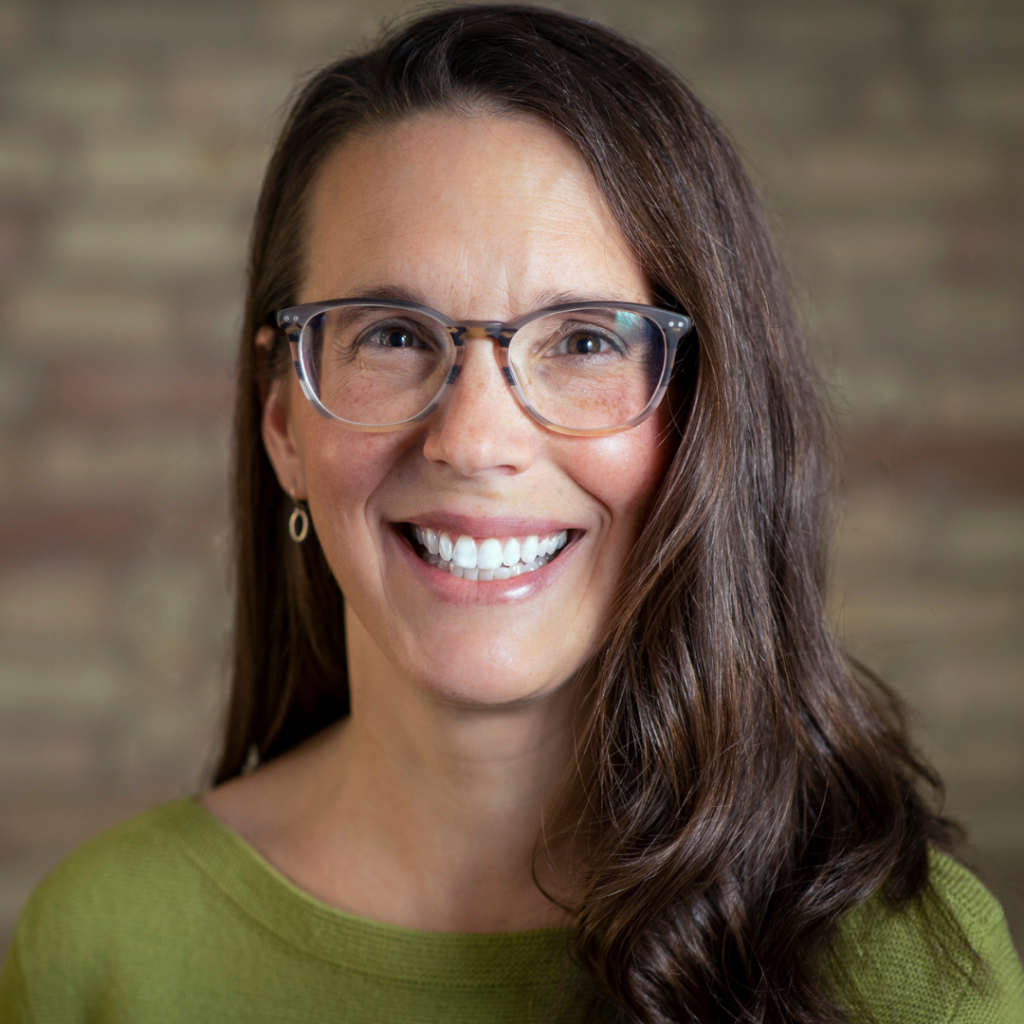
Freya Bradford is the Director of Systems Change and Learning at Rotary Charities of Traverse City. You can reach her at fbradford@rotarycharities.org
Originally publlshed at Rotary Charities
Photo by Alberto Biondi on Unsplash

Network Weaver is dedicated to offering free content to all – in support of equity, justice and transformation for all.
We appreciate your support!
donate in the box above or click here
6 Reasons Why Liberatory Leaders Need to Take Play Seriously
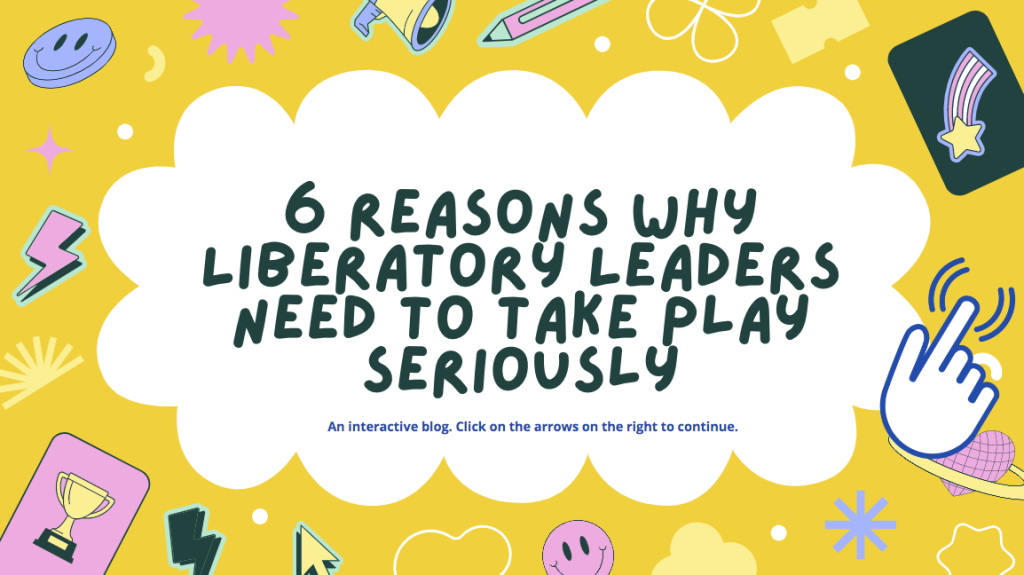
When was the last time you played, did something just because it was fun and felt good? Did you finish feeling enlivened, relaxed, energized, or something similar? Leadership Learning Community has been exploring the roles of fun and play in our activities. This exploration didn’t start out super intentional, but rather as a reaction to the pandopalypse we’ve all been living in. Over time LLC began discussing play in relation to our work, referring to aspects of our work as “playful” or describing meetings and convenings as “play spaces.” For us, this isn’t a cutesy communications strategy. As LLC began to turn our attention to play, we realized that play, when grounded in collective purpose and steeped in values, can be a liberatory act.
Here are six reasons why we believe play can help leaders embrace liberatory practice.
Fuel Ideation
- Play can be described as “something that’s imaginative, self-directed, intrinsically motivated and guided by rules that leave room for creativity.” By creating space for creativity and imagination, play helps to quiet the self-conscious, judgemental inner critic. This voice discourages deviations from the known norm and makes trying on new things feel too risky. Without that voice, perhaps there is room for a little bit of magic to invite in new possibilities. Taking a playful stance allows us to adopt a child-like or beginner's mind, and helps us to develop mental plasticity and adaptability while simultaneously reminding us that our options aren’t all pre-determined and that there is space for the not yet known. This opening of possibility is critical as liberatory transformative efforts are dreaming and imagining into being something that does not currently exist. To do that, we have to stretch our imagination muscles.
- Practice: Start the meeting with a playful check-in question like, “If you could go back in time (or to the future), who would you want to meet?” or pick a favorite zoom filter to start the meeting with. Check out more of our check-in questions here.
Nurture, Healing & Wellness
- Play is an effective way to manage stress and can be a tool of both self and collective care. Play helps us to be in the moment, similar to meditation. In contrast to oppressive practices, which are confining and restrictive, sapping our spiritual and figurative energy; the enlivening nature of playful activities may help to heal these wounds.
- Practice: Host meetings near a park, the ocean, or in nature. Take a walk. Find new analogies for the work we do.
Create New Models of Strategic Thinking
- Playing makes things real, during play we don’t just imitate we also imagine and embody (something). Trying on liberation in play spaces/playful ways allows us to feel the benefit of liberation in the moment while we are learning more than we currently know. This focus on liberation now means that during play liberation doesn’t just have to be a future goal. In addition, some studies suggest that play supports memory and thinking skills, so play may literally help us think our way to freedom.
- Practice: Do some creative writing. Some of us have and are taking a writing course with Dara Joyce Lurie. She shares a quote from Edward de Bono, “Rightness is what matters in vertical thinking. Richness is what matters in lateral thinking. Vertical thinking selects a pathway by excluding other pathways. Lateral thinking does not select but seeks to open up other pathways. With lateral thinking one generates as many alternative approaches as one can. With vertical thinking one is trying to select the best approach, but with lateral thinking one is generating different approaches for the sake of generating them.”
Expand Leadership Opportunities
- Because play utilizes “creative rules” that are distinct from the rules and restrictions of regular life, in play, there exists the opportunity, though not the requirement, to separate capacity from expertise. All of a sudden, players “can” do things even if they aren’t experts at said activity. So you can play at being a pilot without actually knowing how to fly a plane. In playful spaces more people can function as leaders, meaning more people can be actively involved in imagining liberatory practice into being.
- Practice: Acting and improvisation exercises like “Questions Only” where you act out a scene given to you with only questions.
Build Community:
- Play offers us the opportunity to connect. When we create safe play spaces there is little risk to engaging. People can show up with a less performative stance. BIPOC leaders frequently find themselves under a spotlight or a microscope. The labor of being forced to code-switch or deal with being othered is exhausting so I imagine that BIPOC leaders especially are eager for safe spaces to be themselves. Where showing up as one’s whole self is an invitation and a demand, and for the purpose of supporting the BIPOC leader not to be of utility to others. Often BIPOC leaders are told to show up as their full self because observing BIPOC leaders is good for an observer, not for the benefit of the BIPOC leader.
- Practice: Shorten the strategic side of the meeting, and incorporate the karaoke, fun, and games as part of the meeting, not just extra at the end.
An Invitation to Wholeness:
- By allowing us to focus on pleasure and fun rather than objectives and outputs, play encourages us to be more than what we can produce. Perhaps play is akin to rest in that way, and maybe we can view embracing the revolutionary possibility of play in the same way that we have begun to respect how rest can be resistance. This need for play spaces may prove to be especially important for BIPOC leaders given that kids of color are often adultified early, and deprived of the space to play freely. By recapturing play, as we have attempted to reclaim rest, we may enliven our work and find new paths toward liberation.
- Practice: Make space for play at every meeting whether it’s a check-in, the location, the activities, or the bonding event. Make play and joy part of your community agreements so they show up intentionally during your work.
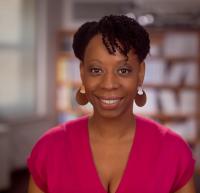
Ericka Stallings is the Co-Executive Director of the Leadership Learning Community (LLC) a learning network of people who run, fund and study leadership development. LLC challenges traditional thinking about leadership and supports the development of models that are more inclusive, networked and collective. Prior to LLC, Ericka was the Deputy Director for Capacity Building and Strategic Initiatives at the Association for Neighborhood and Housing Development (ANHD), supporting organizing and advocacy and leading ANHD’s community organizing capacity building work.

Nikki Dinh is the daughter of boat people refugees who instilled in her the importance of being in community. Though she grew up in a California county that was founded by the KKK, her family’s home was in an immigrant enclave. Her neighborhood taught her about resistance, resilience, joy and love.
originally published at Leadership Learning Community
Network Weaver is dedicated to offering free content to all – in support of equity, justice and transformation for all.
We appreciate your support!
donate in the box above or click here
by Ericka Stallings and Nikki Dinh, co-executive directors of Leadership Learning Community








